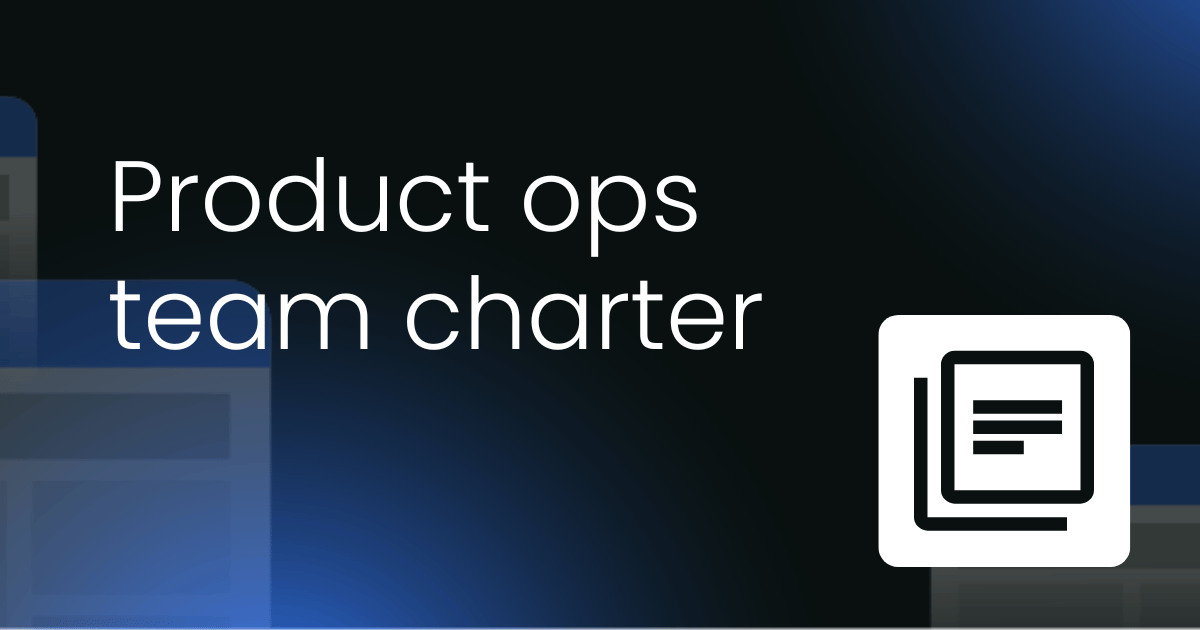For years, the conversation about product ops often revolved around its very existence – "Is it necessary?" or "What is it, exactly?"
However, as our latest State of Product Ops Report shows, those questions are largely behind us. Product ops isn't just necessary; it's established, it's growing, and it's here to stay. With 96% of surveyed product-led organizations now having some form of product ops in place, the function has undeniably matured.
So, if its existence is no longer up for debate, what are the burning questions keeping product ops professionals up at night? Get ready to find out!
This article will explore the biggest hurdles product ops teams are navigating today:
- A lack of clarity in roles and responsibilities
- Difficulty driving cross-departmental alignment
- A lack of resources
More importantly, we’ll dive into strategies to overcome these challenges and ensure your product ops function isn't just surviving, but thriving.
Challenge #1: The persistent problem of role clarity
If you’re in product ops, you’ve probably had to explain what you do more times than you can count. If it makes you feel any better, you’re in good company.
The State of Product Ops Report 2025 highlights that a "lack of clarity in roles and responsibilities" is the number one challenge for product ops practitioners, affecting 29% of formal teams and 28% of informal or solo functions. It’s a universal growing pain, and frankly, it can be a real headache.
Why is this ambiguity so persistent? Well, product ops is a bit of a chameleon. It’s an evolving, hybrid function that often finds itself overlapping with product management, program management, or even inheriting gaps from other operational roles.
As Clare Hawthorne, VP of Product Ops and Head of Technology Product Management at Datavant, aptly puts it, "The lack of clarity in product ops roles is persistent because the function is highly context-dependent."
In other words, what works for a growth-stage SaaS company might look completely different for a mature enterprise. This fluid nature means that pinning down product ops’ responsibilities in your org can be tricky.
The impact of this ambiguity isn’t just annoying; it’s detrimental. It leads to inefficiencies, duplicated efforts (because who really owns that?), internal friction, and makes it incredibly difficult to measure your impact or secure the resources you desperately need.
For 32% of solo or informal product ops setups, this lack of clear boundaries also often means being swamped by a higher volume of ad-hoc requests. You’re doing product ops duties on top of another role, and suddenly, your workload is consumed by repetitive tasks that could easily be delegated if only everyone knew who was responsible for what.
So, how do you cut through the fog?
- Proactive communication and storytelling: You’re not just doing the work; you’re telling its story. Define and articulate the value of Product Ops clearly within your organization. As Chris Butler, Director of Product Operations at GitHub, advises, "Make the value legible, and the role will follow." Don’t wait for others to figure it out; educate them.
- Define boundaries and scope: This might sound obvious, but it’s crucial. Establish clear swim lanes with product management, engineering, marketing, and customer success. Tools like RACI matrices can be your best friend here, helping everyone understand who does what.
- Contextualize the role: Acknowledge that your product ops role will adapt based on your company’s size, maturity, and specific needs. Be flexible, but also firm on your core mandate.
- Internal evangelism: Product ops leaders must actively educate stakeholders on their mandate and capabilities. Host internal workshops, create clear documentation, and consistently communicate your wins. Make your function indispensable.

Challenge #2: Driving cross-departmental alignment and engagement
Product ops is often hailed as the "connective tissue" of a product organization. Yet, our report reveals a fascinating paradox: "Difficulty driving cross-departmental alignment" remains a significant challenge, especially for formal product ops teams (24%). You’re the connector, but sometimes, you’re struggling to make the connection.
While product management is overwhelmingly identified as the primary collaboration partner for product ops (67%), a surprising one-third of respondents didn't prioritize PM as their closest collaborator. This suggests that in some organizations, product ops might be embedded elsewhere or still finding its home.
And even with PMs, ad-hoc collaboration is still the dominant mode for 37% of all respondents, and 33% of centralized teams. This means many product ops professionals are still working in a reactive or informal capacity, rather than strategically embedded.
The engagement gaps don’t stop there. A fifth of respondents reported that fewer than half of product managers actively engage with product ops processes. If you’re building frameworks, optimizing processes, and streamlining workflows, but PMs aren’t using them, what’s the point?
And then there are the customer-facing teams – sales and customer success. Our data shows that for 47% of respondents, collaboration here is often "partially integrated with ad hoc collaboration", so while there’s some strategic involvement, it can be a little inconsistent.
As Topher Fox, Director of Product Operations at Aerospike, states:
"Product operations should work with the ideal consumers of a product management’s output, which includes sales and CS… Sales and CS rely on product teams delivering value to the market to help make customers successful and for deals to close – if product operations isn’t shepherding that, there is a problem."
When product ops isn't tightly integrated here, you get silos, inconsistent customer feedback loops, slower time-to-market, and misaligned go-to-market efforts. Ouch.
So, how do you become the ultimate connector?
- Structured collaboration models: It’s time to move beyond ad-hoc chats. Implement regular cross-departmental meetings with clear agendas and outcomes. Consider establishing dedicated product ops liaisons – 19% of centralized teams are already doing this. This structured approach fosters greater clarity, ownership, and consistent communication.
- Build trust and empathy: As Graham Reed, Head of Product Operations at HeliosX, advises, "Engage with the PMs, take the initiative. Find out what they need, empathise, but also understand what the business needs and is asking of them." Small changes that address their pain points can build immense trust.
- Demonstrate value and quick wins: If PMs aren’t engaging, your work might not feel immediately useful. Chris Butler suggests, "Meet them where they are. Focus on quick wins that remove pain from their day-to-day, and invite them into the process of co-creating solutions." Show, don’t just tell, how you make their lives easier.
- Co-creation: Involve stakeholders in designing processes and solutions. Topher Fox recommends, "Identify your champions: test early and often with them – in fact, treat them as design partners in some cases." When they have a hand in building it, they’ll be invested in its success.
- Integrate customer-facing teams: Proactively embed product ops into workflows that directly impact sales and customer success. This means being involved in everything from product launches to feedback loops, ensuring product value is truly delivered to the market.
Challenge #3: Resource constraints
You’re being asked to do more with less. Sound familiar? Our report confirms it: "lack of resources" is a significant challenge for 17% of formal teams and 24% of informal or solo product ops functions.
Compounding the problem, headcount stability is a mixed bag, with 62% reporting no change and 19% experiencing a decrease.
As Graham Reed points out, "Where product ops has survived, it is being tasked with enabling teams to do more with less, and so themselves they are asked to do more without investment." It’s a tough spot to be in.
Chris Butler adds, "Many organizations still see product ops as a 'nice-to-have' rather than a core function... I also think many companies haven’t yet figured out how to measure or communicate the ROI of product ops, which makes it an easy target during headcount reviews."
It’s time to change that narrative.
Struggling to get the resources you need? Here’s your playbook:
- Strategic investment proposals: When you need more headcount or tooling, don’t just ask – build a compelling business case based on demonstrated and projected value. Show how your proposed investment will directly contribute to the company’s strategic goals.
- Internal talent retention: Chris Butler highlights an often-overlooked but critical metric: "retention of product talent. High retention is a signal that the systems, support, and clarity provided by product ops are making the product org a place where people can thrive." Happy, supported PMs are less likely to leave.
Conclusion: The path forward for product ops
Product operations has come a long way. The widespread adoption we see in the State of Product Ops Report is a testament to its undeniable value.
However, growth doesn't come without friction. The persistent challenges of role clarity, cross-departmental alignment, and resource constraints are real, and they can be frustrating.
But here’s the exciting part: these pain points point directly at the opportunities of tomorrow. The gaps in feedback, collaboration, and resources are fueling a renewed focus on clarity, cohesion, and value demonstration.
So, where does product ops go from here? It’s time to lean into solving these challenges and drive your function forward. The future of product ops – and the products it supports – is in your hands.

Want to dive deeper into the state of product ops? Download the full report for even more insights, data, and expert commentary.



 Follow us on LinkedIn
Follow us on LinkedIn




